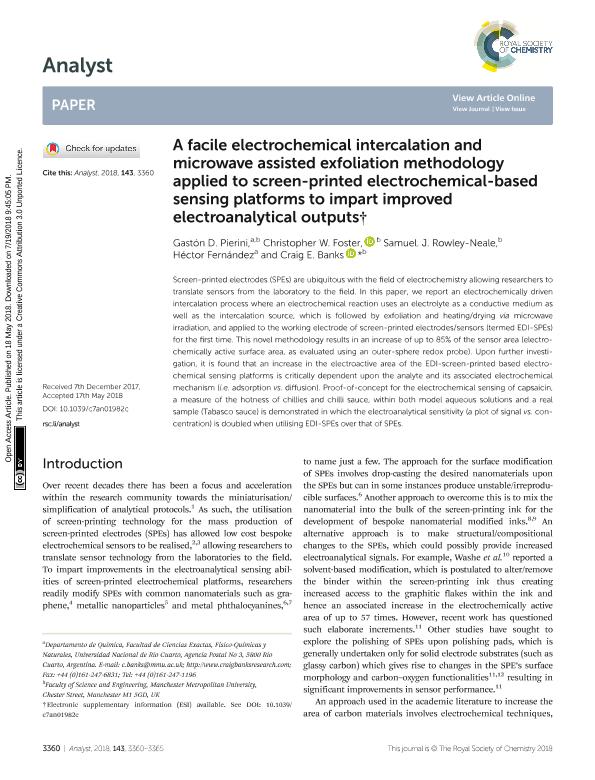Artículo
A facile electrochemical intercalation and microwave assisted exfoliation methodology applied to screen-printed electrochemical-based sensing platforms to impart improved electroanalytical outputs
Pierini, Gastón Dario ; Foster, Christopher W.; Rowley Neale, Samuel. J.; Fernández, Héctor; Banks, Craig E.
; Foster, Christopher W.; Rowley Neale, Samuel. J.; Fernández, Héctor; Banks, Craig E.
 ; Foster, Christopher W.; Rowley Neale, Samuel. J.; Fernández, Héctor; Banks, Craig E.
; Foster, Christopher W.; Rowley Neale, Samuel. J.; Fernández, Héctor; Banks, Craig E.
Fecha de publicación:
06/2018
Editorial:
Royal Society of Chemistry
Revista:
Analyst
ISSN:
0003-2654
Idioma:
Inglés
Tipo de recurso:
Artículo publicado
Clasificación temática:
Resumen
Screen-printed electrodes (SPEs) are ubiquitous with the field of electrochemistry allowing researchers to translate sensors from the laboratory to the field. In this paper, we report an electrochemically driven intercalation process where an electrochemical reaction uses an electrolyte as a conductive medium as well as the intercalation source, which is followed by exfoliation and heating/drying via microwave irradiation, and applied to the working electrode of screen-printed electrodes/sensors (termed EDI-SPEs) for the first time. This novel methodology results in an increase of up to 85% of the sensor area (electrochemically active surface area, as evaluated using an outer-sphere redox probe). Upon further investigation, it is found that an increase in the electroactive area of the EDI-screen-printed based electrochemical sensing platforms is critically dependent upon the analyte and its associated electrochemical mechanism (i.e. adsorption vs. diffusion). Proof-of-concept for the electrochemical sensing of capsaicin, a measure of the hotness of chillies and chilli sauce, within both model aqueous solutions and a real sample (Tabasco sauce) is demonstrated in which the electroanalytical sensitivity (a plot of signal vs. concentration) is doubled when utilising EDI-SPEs over that of SPEs.
Archivos asociados
Licencia
Identificadores
Colecciones
Articulos(CCT - CORDOBA)
Articulos de CTRO.CIENTIFICO TECNOL.CONICET - CORDOBA
Articulos de CTRO.CIENTIFICO TECNOL.CONICET - CORDOBA
Citación
Pierini, Gastón Dario; Foster, Christopher W.; Rowley Neale, Samuel. J.; Fernández, Héctor; Banks, Craig E.; A facile electrochemical intercalation and microwave assisted exfoliation methodology applied to screen-printed electrochemical-based sensing platforms to impart improved electroanalytical outputs; Royal Society of Chemistry; Analyst; 143; 14; 6-2018; 3360-3365
Compartir
Altmétricas



